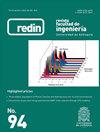Hotspots, daily cycles and average daily dose of PM2.5 in a cycling route in Medellin
IF 0.5
Q3 ENGINEERING, MULTIDISCIPLINARY
Revista Facultad De Ingenieria-universidad De Antioquia
Pub Date : 2020-02-21
DOI:10.17533/udea.redin.20191153
引用次数: 3
Abstract
Bicycle sharing systems are an alternative to promote sustainable transportation and active living. Bicycle users are exposed to traffic and to pollutants in their trips; therefore, the analysis of pollutant concentrations and user exposure is of utmost importance for planning the expansion of creation of these transportation systems. In order to evaluate the concentrations and exposure of cyclists to PM 2.5 , we designed a route within the bicycle sharing system of Medellin and implemented a sensor-based monitoring protocol. Measurements were carried out with a low-cost sensor validated with local information. Potential average daily dose of PM 2.5 was calculated based on the average time of exposure and the level of effort made by the user while riding. Hotspots were identified as the zones on the route with concentrations three standard deviations above the average for each route. PM 2.5 concentrations were found to be highly variable in terms of hour of the day and season of the year. When the concentrations are higher, the potential average daily dose is doubled. There are two types of hotspot according to the built environment configuration on the route, and the concentrations in these hotspots are reaching values considered as harmful for sensitive population groups. The present results are key for the discussion leading to the implementation of measures that will improve the welfare of cyclists in Medellin, that may span from infrastructure intervention to early warning systems.麦德林一条自行车路线的热点、每日循环和PM2.5的平均日剂量
自行车共享系统是促进可持续交通和积极生活的另一种选择。骑自行车的人在旅途中暴露在交通和污染物中;因此,对污染物浓度和用户接触情况的分析对于规划这些运输系统的扩展和创建至关重要。为了评估骑车者对pm2.5的浓度和暴露,我们在麦德林市的自行车共享系统中设计了一条路线,并实施了基于传感器的监测方案。测量是用一种低成本的传感器进行的,该传感器经过了当地信息的验证。PM 2.5的潜在平均日剂量是根据平均暴露时间和骑车者的努力程度计算的。热点被确定为路线上的区域,其浓度高于每条路线的平均值三个标准差。pm2.5浓度在一天中的时间和一年中的季节方面变化很大。当浓度较高时,潜在的平均日剂量增加一倍。根据路线上的建成环境配置,有两类热点,这些热点的浓度正在达到对敏感人群有害的值。目前的结果是讨论实施措施的关键,这些措施将改善麦德林骑自行车者的福利,从基础设施干预到早期预警系统。
本文章由计算机程序翻译,如有差异,请以英文原文为准。
求助全文
约1分钟内获得全文
求助全文
来源期刊
CiteScore
2.00
自引率
0.00%
发文量
27
审稿时长
2 months
期刊介绍:
Revista Facultad de Ingenieria started in 1984 and is a publication of the School of Engineering at the University of Antioquia.
The main objective of the journal is to promote and stimulate the publishing of national and international scientific research results. The journal publishes original articles, resulting from scientific research, experimental and or simulation studies in engineering sciences, technology, and similar disciplines (Electronics, Telecommunications, Bioengineering, Biotechnology, Electrical, Computer Science, Mechanical, Chemical, Environmental, Materials, Sanitary, Civil and Industrial Engineering).
In exceptional cases, the journal will publish insightful articles related to current important subjects, or revision articles representing a significant contribution to the contextualization of the state of the art in a known relevant topic. Case reports will only be published when those cases are related to studies in which the validity of a methodology is being proven for the first time, or when a significant contribution to the knowledge of an unexplored system can be proven.
All published articles have undergone a peer review process, carried out by experts recognized for their knowledge and contributions to the relevant field.
To adapt the Journal to international standards and to promote the visibility of the published articles; and therefore, to have a greater impact in the global academic community, after November 1st 2013, the journal will accept only manuscripts written in English for reviewing and publication.
Revista Facultad de Ingeniería –redin is entirely financed by University of Antioquia
Since 2015, every article accepted for publication in the journal is assigned a DOI number.

 求助内容:
求助内容: 应助结果提醒方式:
应助结果提醒方式:


